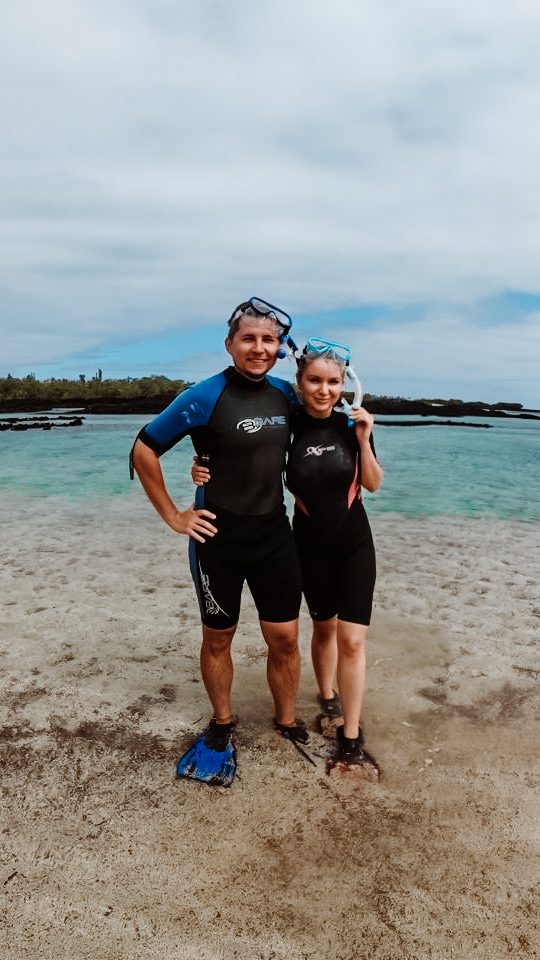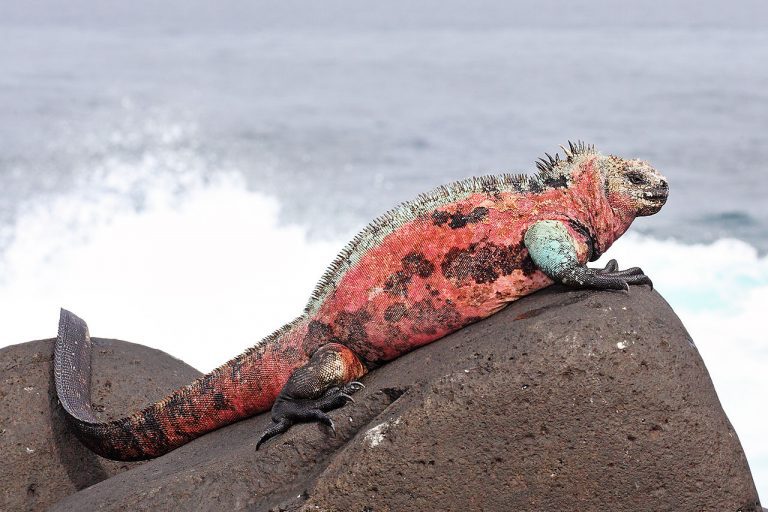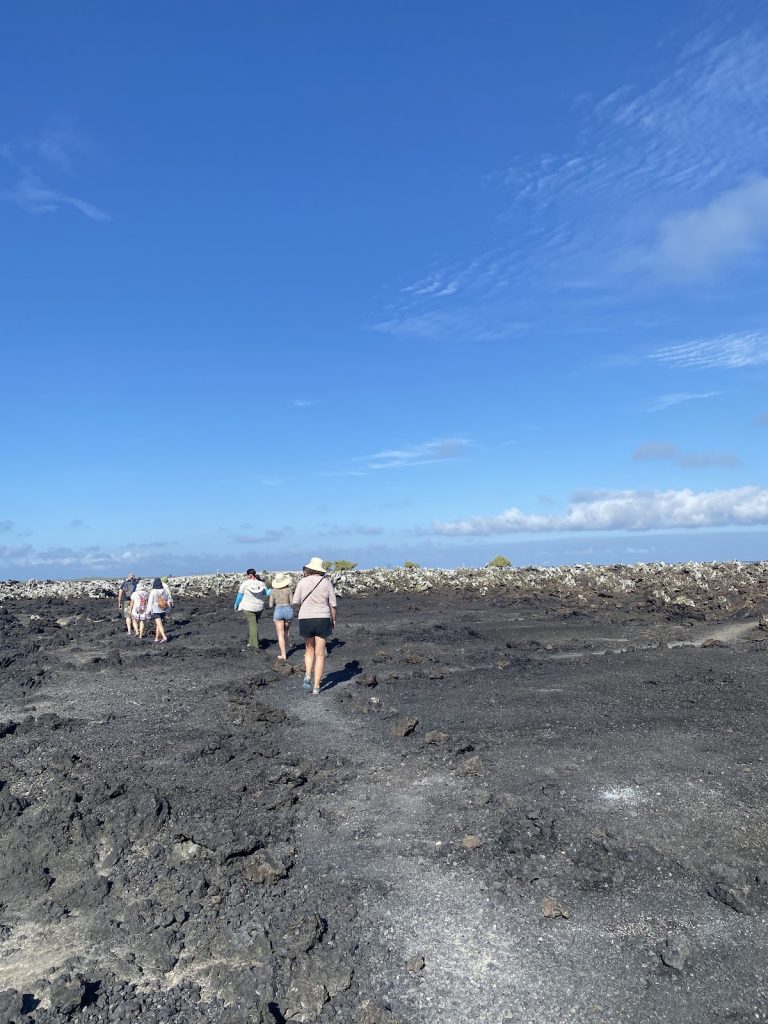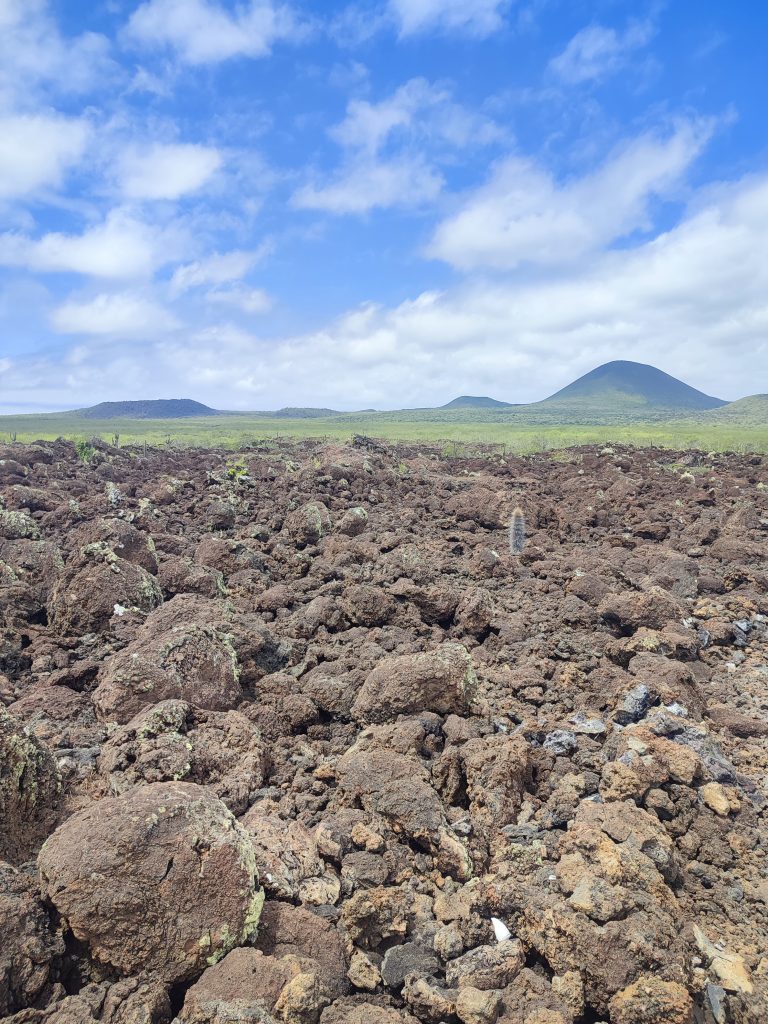Española Island quickly became one of our favorite stops during our Galapagos adventure. As the southernmost and one of the oldest islands in the archipelago, it holds a special place for nature lovers like us.
Being so remote, the island is home to unique creatures that can’t be found anywhere else. We were thrilled to see the Española mockingbird and the colorful Española lava lizard up close. But the absolute highlight was witnessing the iconic Waved Albatrosses. Knowing that this is the only place on earth where they come to nest and breed each year made the experience even more special.
The island is also famous for its vast colonies of blue-footed boobies, Nazca boobies, and other seabirds. And of course, we couldn’t miss the ‘Soplador’ blowhole—a natural wonder that shoots water up to 30 meters into the air when the waves hit just right.
If you’re into snorkeling or sea kayaking, the waters around Española are teeming with life. We found it perfect for exploring marine species up close. This post will guide you through our memorable experience on Española Island, including the must-see wildlife and the best spots to explore.
Looking back, visiting Española Island required careful planning – from choosing between day trips vs. cruises to timing our visit for specific wildlife encounters. Skip the uncertainty I faced and get a FREE personalized Galapagos trip quote from my trusted local experts who know exactly when and how to experience this incredible island. Your booking helps support both this blog and local Galapagos communities.
Plan perfect trip to Ecuador & Galapagos
I spent countless hours researching everything about traveling to Ecuador, and I created this blog for fellow travel enthusiasts who want the best, most reliable information. But if you want to save time, we’ve partnered with the top local agency to plan your dream trip.
How to Get to Española Island
Española Island Attractions
As soon as we set foot on Española, it became clear why it’s renowned for having the highest number of endemic species in the Galapagos. The island is uninhabited by humans, which means it’s truly a sanctuary where nature thrives undisturbed. We were surrounded by wildlife the moment we arrived, with the landscape untouched and vibrant.
It was a refreshing change to be somewhere so pure, where animals roam freely without any signs of human development. The experience felt like stepping into a different world, one where nature is fully in control.
Suarez Point
Our visit to Suarez Point was one of the most thrilling experiences we had on Española Island. We were dropped off at a small concrete pier beside a modest lighthouse, and from the moment our feet touched the ground, we could feel the vibrant energy of the place. It was as if we had stepped straight into the heart of the Galapagos wildlife spectacle.
The first thing that caught our eye were the bright Sally Lightfoot crabs clinging to the jagged black lava rocks, their vivid reds, oranges, and yellows contrasting sharply with the dark stones. Baby sea lions played joyfully in the shallow waters, and just a few steps into our hike, we spotted an Española Marine Iguana—affectionately known as the Christmas Iguana because of its unique red and green coloration. Naturally, we paused for some photos, but we knew the best was yet to come.
Leaving the beach, we followed the trail that meandered towards the coast. Along the way, we were ‘harassed’ (in the best way possible) by Española Mockingbirds. These fearless little birds are notorious for approaching tourists in search of a sip of water. They were so close that we could have touched them, but as tempting as it was, we resisted the urge to share our water with them.
The terrain soon became more challenging, as we navigated through a maze of volcanic rocks. We caught sight of a few Galapagos doves fluttering nearby and even spotted a Galapagos hawk soaring above. Finally, after a bit of a scramble, we reached the cliff plateau and found ourselves right in the middle of the waved albatross breeding grounds. This, to me, was the true reward for our efforts.
Every year, starting in April, the majestic waved albatrosses flock to Española Island to mate and nest. Watching them engage in their elaborate mating dance was nothing short of magical. These birds mate for life, and their gentle, affectionate behavior was heartwarming to witness. By June, the area is filled with fluffy white chicks, a sight that truly embodies the cycle of life on this remote island.
Continuing along the cliffs, we were treated to stunning ocean views, culminating in the spectacular sight of the famous Punta Suarez blowhole, known locally as El Soplador. Here, waves forcefully crash against an opening in the rocks, sending water jets as high as 23 meters (75 feet) into the air. We were all in awe, mesmerized by the power and beauty of nature on full display.
The final leg of our journey took us back down to sea level, where we were greeted by a large colony of blue-footed boobies. These comical birds, often called the clowns of the Galapagos, delighted us with their quirky mating dance. The area was also home to Nazca boobies and Red-billed Tropicbirds, which we saw gracefully gliding along the cliff edges.
Eventually, we made our way back to the beach by the lighthouse, our hearts full from the incredible encounters and unforgettable memories we made at Suarez Point.
Gardner Bay
After a quick lunch break on the boat, we were ready to explore a different part of Española Island: Gardner Bay. And let me tell you, it was love at first sight.
Gardner Bay was once named one of CNN’s top 20 beaches worldwide, and the moment we stepped onto its pristine shores, we understood why. The wet beach landing brought us straight onto a stretch of soft, powdery white coral sand, with the mesmerizing turquoise waters gently lapping at the coast.
But before we could fully appreciate the stunning scenery, we were instantly captivated by our unexpected beach companions: a colony of sleepy sea lions. It was impossible to ignore them! Some were lazily sunbathing in clusters, while others took a refreshing dip in the crystal-clear waters.
There’s a popular joke in the Galapagos that tourists get incredibly excited when they first see a sea lion up close—only to grow indifferent after a few days since they’re literally everywhere! Still, we couldn’t help but smile at the sight of these adorable creatures. We were instructed to keep our distance, especially since sea lions can be protective of their pups and personal space. But as I sat down on the glistening white sand, I quickly found myself surrounded by sea lions lounging around, completely unfazed by our presence.
Our memorable visit to Española concluded with a quick dip near Tortuga Rock, also known as Turtle Rock. The rock earned its name because it resembles a Green Sea Turtle surfacing for air.
The real adventure, though, awaited on the far side of Turtle Rock, where the waters were perfect for experienced snorkelers and confident swimmers. Here, the vibrant marine life was on full display. We were fortunate enough to swim alongside whitetip reef sharks, graceful manta rays, and an array of colorful reef fish like Surgeonfish, Parrotfish, Wrasse, and Scorpionfish.
The shallow waters around the islet provided ideal conditions for snorkeling. To our delight, we even spotted a small penguin darting playfully among the vivid tropical fish. And as if that wasn’t enough, an unexpected turtle swam past us, adding a perfect finishing touch to our adventure.
Gardner Bay and Tortuga Rock left us in awe, and it was the perfect way to cap off our incredible day on Española Island. It’s an experience that will forever remain etched in our hearts!
Have questions about your upcoming Galapagos trip? Join my Galapagos Reddit community and ask other travelers who recently visited the islands. Get up-to-date tips, real experiences, and honest advice from other travelers (I ban tour agencies and resellers).
Gardner and Osborne Islets
Gardner and Osborn Islets, right next to Española Island, are a paradise for snorkeling enthusiasts like us. Here, we found ourselves surrounded by mesmerizing 80-foot sea depths that cascade down coral cliffs into hidden underwater caverns. These caverns serve as bustling cleaning and feeding stations, where we were lucky to spot eagle rays, majestic manta rays, jacks, Galapagos sharks, and even some curious white-tip reef sharks. For a brief moment, we thought we glimpsed the shadow of a hammerhead shark in the distance, which added a whole new thrill to the experience.
The marine life here was nothing short of spectacular. Massive schools of vibrant reef fish moved gracefully around us, zipping back and forth among playful sea lions and serene sea turtles. As we swam closer to the sandy seabed, we kept our eyes peeled for something truly unique—and then, we saw it! The rare red-lipped batfish, with its quirky appearance and bright red lips, seemed to pose for us, adding an unforgettable touch to this underwater adventure. Snorkeling here was one of those moments that made our entire trip to the Galapagos feel like a dream come true.
Trust me, while Española Island is amazing as a day trip, experiencing it as part of a well-planned Galapagos cruise makes all the difference! Want to maximize your wildlife encounters and snorkeling opportunities without feeling rushed? Get a FREE expert itinerary from my recommended local agency who can help create your perfect Galapagos adventure. Your booking supports this blog and local Galapagos businesses.
When to Visit
There’s really no perfect time to visit Española Island when it comes to weather since it stays fairly dry most of the year. However, we found that the waters around the island are warmer from January to April, making it an ideal time if you’re keen on snorkeling.
For many visitors, though, the real highlight of Española Island is witnessing the incredible waved albatross. We learned that these fascinating birds are best spotted between April and December. While they mostly disappear from the island from January to March, there’s a chance you might spot a few early returners in March or some stragglers still around in January. But if you’re like us and want the best chance to see them, plan your trip between April and September. That’s when we were able to witness their impressive courtship displays—it was truly a magical experience!

Planning trip to Galapagos Islands?
My wife and I spent two weeks on these magnificent islands, visited nearly every possible tour, and explored as much as we could. I shared all the important details in my comprehensive Galapagos Islands Travel Guide, where I cover everything you need to know about planning a trip to the Galapagos.
Galapagos Islands travel might surprise you with extra fees to enter the islands, the complicated logistics between islands, booking tours, and knowing which spots are free to explore and which ones are not. I’ve covered it all in this Galapagos Travel Guide.
Also, if you’re planning a trip to the Galapagos, make sure to use my link for discounted hotel prices via Booking.com. It really helps support my blog!
Bottom Line
Española Island will truly take your breath away! My wife and I highly recommend adding it to your Galapagos itinerary because it is absolutely worth the visit.
The stunning contrast between the rugged black cliffs and the pristine white sand beaches blew us away. We found that the variety and abundance of species here surpass those of any other Galapagos island we visited. Unique creatures like the majestic waved albatross and the colorful Christmas iguanas captivated us. The experience is non-stop, with action both on land and in the water. Española Island remains one of the most unforgettable highlights of our Galapagos adventure, and the memories and photos we brought back will always remind us of its magic.
Plan perfect trip to Ecuador & Galapagos
I spent countless hours researching everything about traveling to Ecuador, and I created this blog for fellow travel enthusiasts who want the best, most reliable information. But if you want to save time, we’ve partnered with the top local agency to plan your dream trip.




